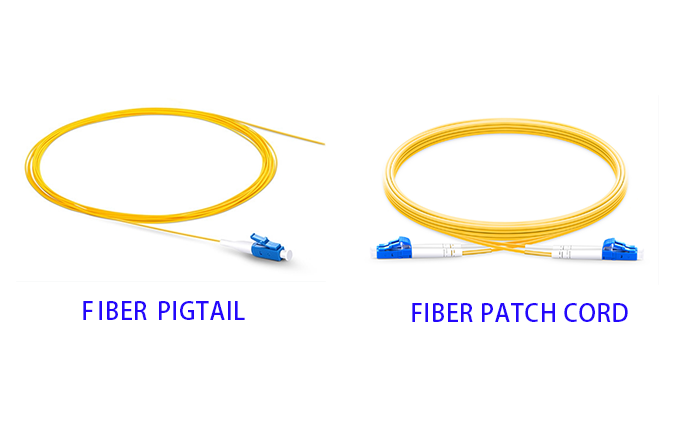Understanding Fiber Pigtail vs Fiber Patch Cord for Optimal Network Performance

Fiber Optic Connections
Role of Fiber Pigtail and Patch Cord
Fiber pigtail and fiber patch cord are crucial components in fiber optic networks. The fiber pigtail serves as a permanent connection, while the fiber patch cord offers flexibility for temporary connections, making it ideal for network maintenance and reconfiguration.
Understanding the differences between these two components is essential for optimizing network performance. Both the fiber pigtail and fiber patch cord play vital roles in adhering to network cabling standards and ensuring efficient optical fiber transmission.
Role of Fiber Pigtail and Patch Cord
Distinguishing Characteristics
When comparing fiber pigtail and fiber patch cord, it's essential to understand their unique characteristics. The fiber pigtail is designed for permanent connections within fiber optic networks, providing a stable and long-term solution for network infrastructure. On the other hand, the fiber patch cord offers the flexibility required for temporary connections, making it well-suited for network maintenance and reconfiguration tasks.
Versatility in Network Configurations
In network design, both the fiber pigtail and fiber patch cord serve crucial roles in adhering to established network cabling standards. While the fiber pigtail ensures a reliable permanent connection, the fiber patch cord facilitates adaptability by allowing for changes in network configurations when necessary.
Adherence to Standards
The use of both components is instrumental in ensuring efficient optical fiber transmission, as they contribute to maintaining compliance with industry standards. By integrating these components into network design, organizations can achieve optimal performance while upholding best practices in cabling and connectivity.
Cabling Standards and Transmission
Compliance with Standards
Adhering to network cabling standards is imperative for maintaining the integrity and performance of fiber optic networks. These standards outline the best practices and requirements for cable installation, ensuring that data transmission remains reliable and efficient. Understanding the intricacies of these standards is crucial for network performance optimization, as it allows for the implementation of proper installation techniques and cable management practices. By adhering to these standards, organizations can minimize signal interference, reduce the risk of network downtime, and ensure consistent data transmission quality.
Optical Fiber Transmission
Efficient optical fiber transmission forms the backbone of high-performance networks. It is essential to select the appropriate fiber optic cables to achieve optimal data transmission. The right choice of cables directly impacts the reliability and speed of data transfer within the network. By prioritizing efficient optical fiber transmission, organizations can ensure seamless communication and data exchange across their infrastructure, ultimately leading to improved operational efficiency and productivity.
Optic Connectors and Splicing
Understanding Fiber Optic Connectors
When it comes to fiber optic networks, the use of fiber optic connectors is essential for enabling seamless connectivity. These connectors come in various types, each catering to specific network applications and requirements. Proper installation and regular maintenance of fiber optic connectors are crucial for ensuring the reliability and performance of the network. By maintaining these connectors, organizations can minimize signal loss and ensure consistent data transmission across their infrastructure.
The versatility of fiber pigtail connections in conjunction with fiber optic connectors allows for the seamless integration of permanent connections within the network. This integration ensures stable long-term connectivity while also facilitating efficient data transmission. Understanding the different types of fiber optic connectors and their respective applications empowers organizations to make informed decisions regarding their network infrastructure, ultimately leading to optimized performance and reliability.
Importance of Fiber Optic Splicing
In optical fiber networks, fiber optic splicing plays a critical role in creating uninterrupted connections between fiber optic cables. Effective splicing techniques contribute significantly to the overall performance and durability of the network by minimizing signal loss and enhancing data transmission efficiency. By employing proper splicing methods, organizations can ensure that their networks operate at peak performance levels, supporting seamless communication and data exchange.
Effective utilization of both fiber pigtail connections and fiber optic splicing techniques is fundamental for establishing robust, high-performance fiber optic networks that meet the demands of modern data transmission requirements.
Testing, Technology, and Management
Fiber Optic Testing
Ensuring the reliability and performance of a fiber optic network requires thorough fiber optic testing. By conducting comprehensive tests on the fiber patch cord connections and overall network infrastructure, potential issues can be detected and resolved proactively. Utilizing advanced testing technologies, such as optical time-domain reflectometers (OTDR) and optical power meters, enables network administrators to assess signal quality, identify any signal loss or degradation, and pinpoint the exact location of faults within the network.
Effective fiber optic testing not only validates the integrity of the connections but also contributes to the overall optimization of network performance. It provides valuable insights into the quality of data transmission, allowing for preemptive maintenance and troubleshooting. With regular testing protocols in place, organizations can ensure that their fiber optic networks operate at peak efficiency while minimizing downtime due to unforeseen connectivity issues.
Effective Cable Management
Implementing proper cable management practices is essential for maintaining the overall efficiency and organization of a fiber optic network. By organizing and securing fiber patch cord connections along with other cables, organizations can minimize the risk of signal interference and potential disruptions in data transmission. Efficient cable management also simplifies maintenance tasks, making it easier to identify and address connectivity issues promptly.
Adhering to established network cabling standards for cable routing and organization ensures that the physical infrastructure supports optimal data transmission without impedance or signal loss. Proper labeling, bundling, and routing of cables contribute to a well-organized network environment, enhancing accessibility for maintenance personnel while promoting consistent performance across the entire fiber optic infrastructure.
Optimizing Network Performance
Achieving Peak Performance
To achieve peak performance in fiber optic networks, mastering the utilization of fiber pigtail and fiber patch cord is paramount. A comprehensive understanding of these components, along with effective fiber optic testing and proper cable management, is imperative for ensuring high-performance networks.
Embracing Efficiency Through Connectivity
Efficient optical fiber transmission relies on the seamless integration of fiber optic connectors and the strategic deployment of fiber pigtail and fiber patch cord connections. By optimizing network design with these components, organizations can enhance data transmission efficiency and minimize signal loss.
Proactive Maintenance Strategies
Implementing proactive maintenance strategies through regular fiber optic testing allows for the early detection and resolution of potential connectivity issues. This approach ensures that the network operates at peak efficiency while minimizing downtime due to unforeseen faults.
Streamlined Cable Management
Efficient cable management practices, including proper labeling, bundling, and routing of cables, contribute to a well-organized network environment. This promotes consistent performance across the entire fiber optic infrastructure while simplifying maintenance tasks.
See Also
Enhancing Network Efficiency with FiberHome Fiber Optic Technology
Attaining Optimal Performance and Affordable Fiber Optic Connection
Discovering the Advantages of the 960 Core Fiber Optic Splice Enclosure
Weatherproof FTTA Patch Cable: OptiTap's Robust Outdoor Connection Solution


